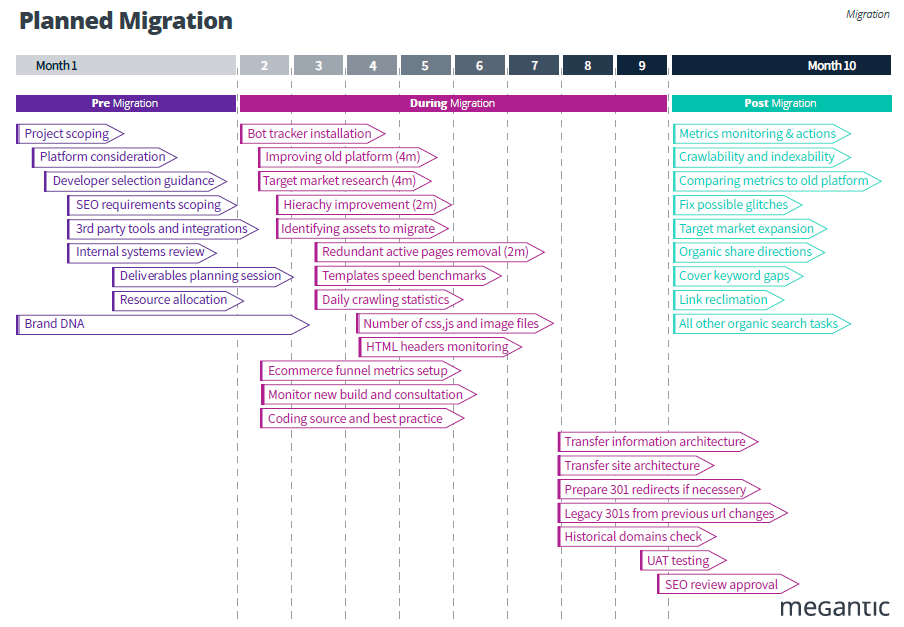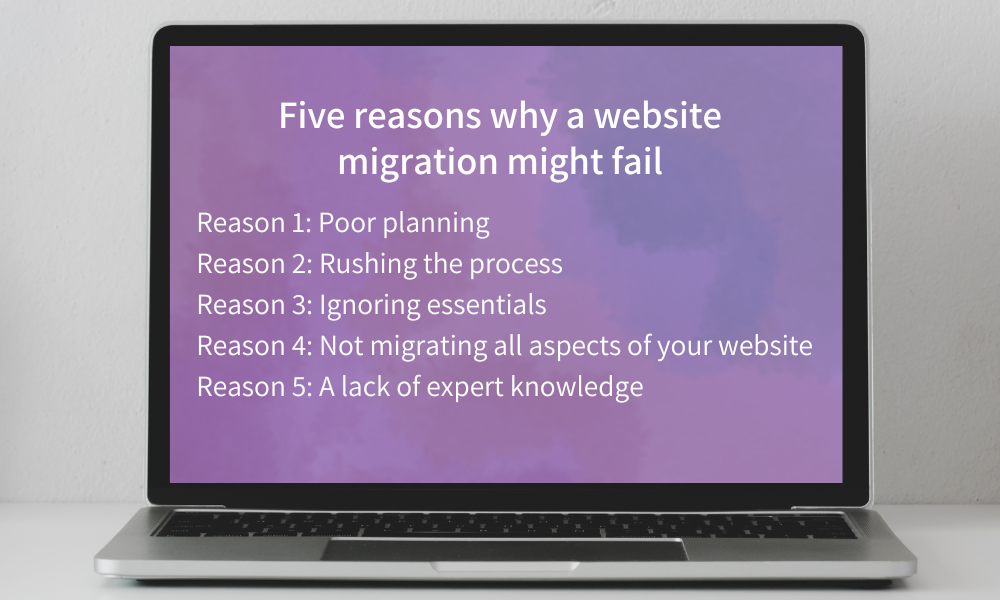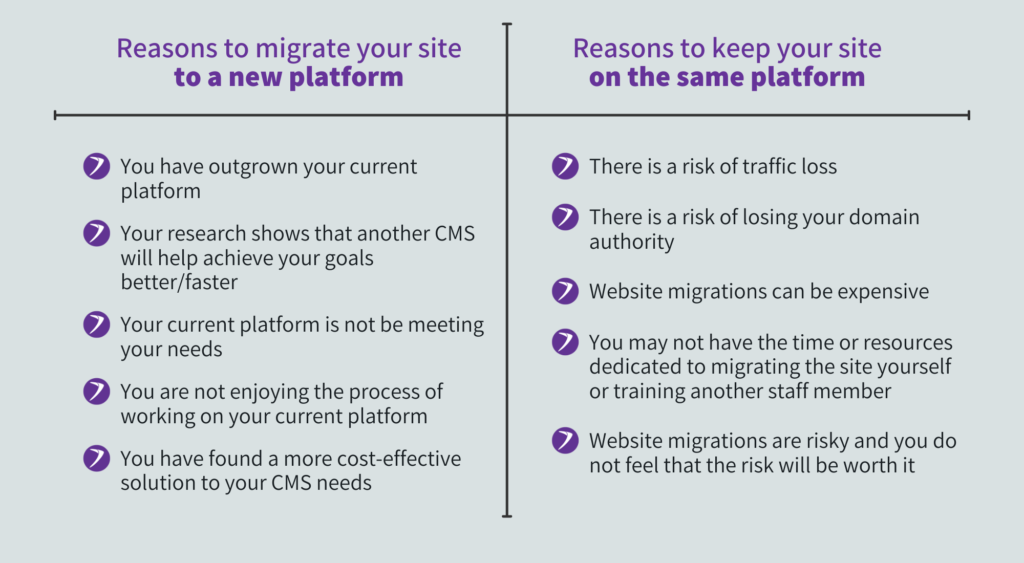Website Migration Q&A | Site Migrations 101
1 July 2022 Blog Posts
Website migrations can be confusing, and we’re sure you have many questions, so let’s get to the bottom of them in this website migration Q&A.
First, read What is a Site Migration, then discover the Migration Process, and finally, learn what to do if a Migration Fails.
Contents
- What is a site migration?
- Which CMS are most migrations moving to?
- How long does a migration typically take?
- What is the process Megantic goes through for a migration?
- How much does it cost to migrate to a new platform?
- How much do you communicate with website developers during a migration?
- What do you do if you notice an issue with the migration, like a sudden drop in traffic?
- Will the website be down during the migration?
- What if the site goes down after the migration?
- Will a migration help my website grow?
- Why should/shouldn’t a website owner migrate to a new CMS?
Migration Q&A: What is a site migration?
“A website migration is the process of transferring and trying to maintain search engine keyword rankings and authority, during a large website restructuring, such as moving CMS platform or updating the existing one.” – Heath Hamilton, Technical Project Manager.
“A site migration is a process of changing the current website platform (usually an old or out to date platform) to another new platform that will suit best in relation to required functionalities. For example, if the old platform is old and does not support modern SEO requirements, it can be changed to a newer platform that complies with modern Web Standards.” – Rudy Kurniawan, Web Producer & Project Manager.
Which CMS are most migrations moving to?
We see a lot of migrations moving Shopify, Maropost and Magento 2.

How long does a migration typically take?
It typically takes us around 10 months to complete a website migration.
What is the process Megantic goes through for a migration?
Month 1 is pre-migration. In this stage, we look at everything that will need to be migrated, form a project scope and decide on deliverables and the correct resource allocations.
Months 2 through 9 are when the migration is in process. We install a bot tracker, improve the old platform with our 3 stage strategy and transfer the site and information architecture.
The migration is usually completed by month 10, however this can vary based on a variety of factors. During this post migration stage, we uncover keyword gaps, address historical 301s and reclaim links.
Learn more about the migration process in our past blog, The Migration Process.

Migration Q&A: How much does it cost to migrate to a new platform?
This depends on the how much development time would be needed, this is usually to do with:
- The old platform and new platform
- What functionalities needed for the website
- The website design
A website migration can usually cost between $10,000 to $300,000. The smaller figure would be for small businesses moving and building on a Shopify platform whereas the larger figure would be for an enterprise-level business moving and building a website on the Magento 2 platform.
How much do you communicate with website developers during a migration?
It depends! The platform would be the main variable to determine how many hours go into consulting with developers. For a small SEO migration, we would expect anywhere from 40 hours upwards. For a large or custom platform migration, it will need up to 400 hours if the migration process takes up to 1 year.
What do you do if you notice an issue with the migration, like a sudden drop in traffic?
Most migrations will see some fluctuations in traffic and rankings within the first 3 months of going live as it takes time for Google to re-evaluate and re-index your new website pages. If there is prolonged drop in traffic then there is likely to be an issue that needs to be addressed. The most common reasons for big drops are no 301 redirects implemented from old site to new site. Following that we see lots of fluctuations caused by URL changes or on-site SEO elements like H1, metadata or content are removed or different to what they used to be previously.
Learn more about why a website migration might fail and what to do in our blog post, What to do if your Site Migration Fails.

Will the website be down during the migration?
The migration process usually happens on a staging environment before being sent live onto the actual website. Once the migration is all working on the staging environment, it will be pushed to the live environment. Only during this process will the site be down, usually between 1 and 5 hours depending on how big the website is.
What if the site goes down after the migration?
If a site goes down after migration, the first thing to do is to update the homepage to show visitors that the website is under maintenance. Then developers can review the site to see if there are any technical issues with the server or platform.
To avoid this issue, there are some important steps to take before the new website goes live. For example, your developers should set Robots to disallow indexing of the new website until it is confirmed that there are no technical issues with the deployment.
A full back-up of the working staging site and database needs to be created prior to the roll out of the new site. This allows the developers to quickly restore the deployment to the latest known working state.
If your site goes down after a migration, contact the developer who is handling the migration immediately.
Migration Q&A: Will a migration help my website grow?
The growth of a website depends on several crucial factors including (but not limited to) name recognition, trust/loyalty of your customers, website usability, up to date content and a robust platform.
A site migration will give a website the opportunity to recreate a new and solid foundation to allow the website to run on the modern web. This affects the ability of the website to enable multi-platform integration, to take advantage of modern SEO practices and to have a high performance when serving a high amount of traffic. Along with responsiveness, a user friendly website with a frontend design and credibility, all contribute to making a successful website.
Migration Q&A: Why should/shouldn’t a website owner migrate to a new CMS?
With how rapidly web technologies are developing, a migrated platform may only last for 4 to 5 years. That said, when a website owner notices that their website functionalities can no longer keep up with their current aims and business purposes, they are advised to find a new and better platform, as soon as resources are available.
Some other considerations for choosing to migrate include lower maintenance cost, system performance, newer features and more security.
If a website is not heavily affected by those issues, a site migration may not be urgently required, but keeping up to date with the modern standards is still recommended.

If you have any further questions about website migrations or have another website migration Q&A, chat to our migration specialists today (we can even throw in a free website analysis).





